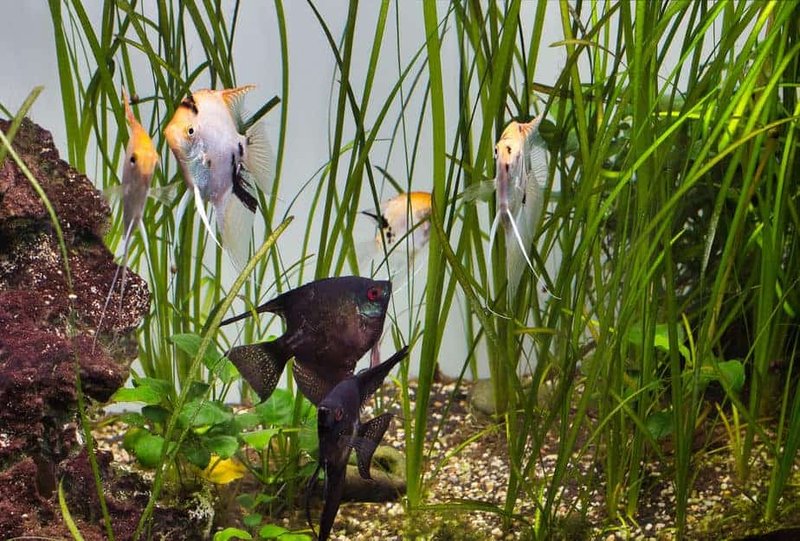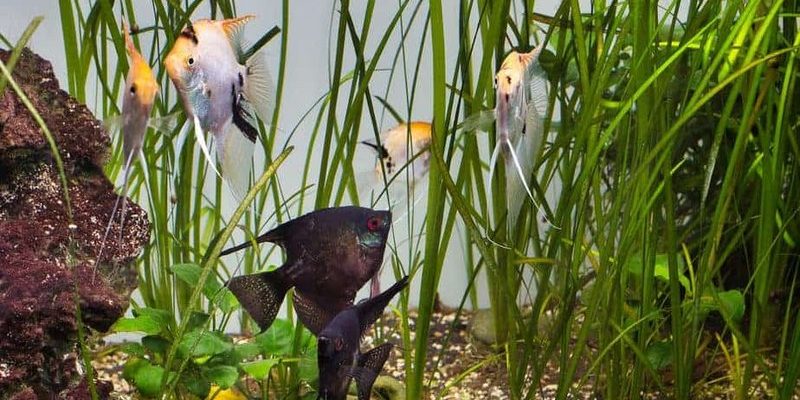
Choosing the right plants and substrate is like picking the perfect ingredients for a delicious recipe. Both play crucial roles in maintaining water quality, providing shelter, and promoting a thriving ecosystem. If you’re new to the fish-keeping world, don’t worry! Let’s dive deeper into the essential details and help make your angelfish tank a stunning success.
Why Are Plants Important in Angelfish Tanks?
Plants are much more than just decoration in your angelfish tank; they’re vital for creating a healthy environment. They help improve water quality by absorbing nutrients and carbon dioxide, releasing oxygen, and providing a habitat for beneficial bacteria. This natural filtration system creates a stable environment that your fish will thrive in.
Additionally, plants offer shelter for your angelfish, particularly when they’re feeling shy or stressed. Just like how we sometimes need our personal space, angelfish appreciate having a place to hide. Providing them with plants like Java Fern or Anubias not only makes the tank look good but also gives your fish a place to retreat and feel safe.
Let’s not forget about the aesthetic appeal! A well-planted tank creates a beautiful focal point in any room. You might find yourself mesmerized by the way the plants sway gently with the water’s movement, making your tank a true aquatic masterpiece.
Best Plants for Angelfish Tanks
When it comes to selecting plants for angelfish tanks, it’s essential to pick varieties that can handle both the water conditions and the fish themselves. Here’s a look at some of the best options:
- Java Fern: This hardy plant thrives in low light and can grow attached to rocks or driftwood. It’s low-maintenance, making it perfect for beginners.
- Anubias: Another easy-to-care-for choice, Anubias can also be attached to surfaces. It has broad leaves that can withstand the occasional nibble from your fish.
- Swords (Echinodorus): These plants can get quite large and provide ample hiding spots. They do well in nutrient-rich substrates, so keep this in mind!
- Water Wisteria: This fast-growing plant provides excellent coverage and helps absorb excess nutrients, keeping the water clean and clear.
- Amazon Sword: A classic choice for larger tanks, Amazon Swords are beautiful and add a lush, green backdrop to your aquarium.
Before you make your final selections, consider the size of your tank and the lighting conditions. Some plants may thrive in low light, while others may need brighter, more intense light.
Understanding Substrate Types
Now that you’ve got some plant options in mind, let’s talk about substrate. The right substrate can make a world of difference in how well your plants grow and how comfortable your angelfish feel in their home. There are a few different types to choose from, and each has its pros and cons.
You might be wondering about the difference between gravel and specialized substrates. Here’s the deal: gravel is an inexpensive option that provides decent drainage but doesn’t necessarily support plant growth. On the other hand, plant substrates are designed to provide nutrients directly to your plants’ roots, making them a great choice for aquariums with heavy planting.
Some popular options include:
- Soil-based substrates: These are rich in nutrients and great for plant growth. They can be a bit messy to work with but are often worth the effort.
- Clay substrates: These provide good water flow and are often used in combination with other substrates to enhance plant growth.
- Gravel: While not the best for plants, gravel is easy to clean and allows for good water flow. Some fish keepers mix it with soil or special plant substrates.
Keep in mind the needs of your plants. If you plan on a heavily planted tank, investing in a good nutrient-rich substrate is the way to go. It can make a huge difference in how lush and healthy your plants become.
How to Set Up Your Angelfish Tank
Setting up your tank correctly is crucial for the overall health of your angelfish and the plants you choose. Here’s a step-by-step guide to get you started:
1. Choose the right tank size: Angelfish need space to swim. A minimum of 20 gallons is recommended.
2. Select your substrate: If you’re going for a nutrient-rich substrate, layer it at the bottom of the tank. Aim for 1-2 inches, depending on your plants’ needs.
3. Add decorations: Rocks, driftwood, or caves are great for adding depth and hiding spots. Position these first before adding water.
4. Plant your plants: Start with the taller plants in the back and shorter ones in the front for a well-balanced look. Make sure to bury their roots well.
5. Fill the tank with water: Slowly pour water in to avoid disturbing your plants too much. You might want to use a plate or bowl to help with this.
6. Cycle the tank: Before adding your angelfish, wait for the tank to cycle. This can take several weeks but is crucial for establishing beneficial bacteria.
7. Monitor water parameters: Keep an eye on your ammonia, nitrite, and nitrate levels to ensure your fish have a safe environment.
Remember, patience is key! Rushing the process can lead to problems down the line, so take your time in setting everything up.
Maintaining Your Plants and Substrate
Once your angelfish tank is up and running, maintaining it is the next step. Healthy plants and substrate mean happy fish! Here are a few tips on how to keep everything in tip-top shape:
– Light: Ensure your plants are getting the right amount of light. Most require 10-12 hours of light daily, so consider using a timer to keep it consistent.
– Fertilization: Depending on your substrate and plant types, you may need to add fertilizers. Liquid fertilizers can help supplement nutrient needs.
– Pruning: Regularly trim your plants to prevent overgrowth and maintain a neat appearance. Plus, this helps to promote new growth!
– Substrate vacuuming: When doing water changes, use a substrate vacuum to clean out any debris. Just be careful around the roots—some plants don’t like being disturbed too much.
Keeping a routine can make maintenance less daunting. You’ll soon find your rhythm, and your tank will flourish beautifully!
Common Problems and Solutions
Even with the best planning, problems can arise in your angelfish tank. Here are some common issues and quick fixes to keep in mind:
– Algae growth: If you notice excessive algae, it’s likely due to too much light or nutrients. Try reducing the light or adjusting your fertilization schedule.
– Plant wilting: If your plants look droopy, they might not be getting enough light, or their roots could be struggling. Check your light source and ensure the substrate is nutrient-rich.
– Fish nibbling on plants: Some angelfish may nibble on softer plants. If this becomes a problem, consider switching to more robust varieties like Anubias or Java Fern.
Here’s the thing: keeping an aquarium can be a bit of a learning curve. Don’t get discouraged! Every problem is a chance to learn more about your fish and plants.
Creating the perfect environment for your angelfish doesn’t have to be overwhelming. By choosing the right plants and substrate, you set the stage for a beautiful and thriving aquarium. Remember, plants like Java Fern and Anubias are excellent options for beginners, while using nutrient-rich substrate can greatly enhance their growth.
As you embark on this journey, be patient and open to learning. Each tank is unique, just like each fish has its personality. With a little care and creativity, your angelfish tank can become a stunning aquatic paradise that brings joy to your life. Happy fish-keeping!

